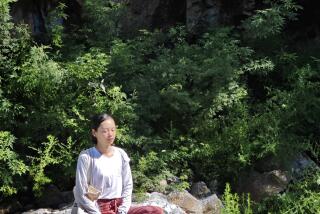‘Let’s Go’ Series Navigates China’s Challenging Maze for Travelers
- Share via
For the independent adventurer, China can be a challenge. Traveling without a guided tour is complicated in this huge country. One source for the intrepid young traveler is the 48-title “Let’s Go” guidebook series, which is researched annually by Harvard students and has introduced its first edition of “Let’s Go: China” (St. Martin’s Press, $24.95).
Deciding what to see--the Forbidden City, the Great Wall, the buried army of terra-cotta warriors in Xian, giant pandas in Sichuan--is difficult because of the distances between the sites. Adventurers may also want to sleep in a yurt on the grasslands of Mongolia, travel on the trans-Siberian railway or hike from Tibet to Nepal.
“Let’s Go: China” helps with some suggested itineraries, then follows through with more than 700 pages of historical background, details on the sights and how to see them on a student-style budget, emergency contacts, transportation, accommodation, ticketing services, communications opportunities (including Internet services) and a phrase book.
One helpful feature of the guidebook is that many key words (tourist sights, hotel names, transportation services) have Pinyin transliterations and Chinese characters, so you can take a stab at pronouncing the word or simply point to it when you need someone to steer you in the right direction.
Not only does the guide cover the main destinations and sights, but it also describes two destinations that have become popular with backpackers: Yangshuo in Guangxi province and Dali in Yunnan province.
“Both are small towns blessed with natural splendor, mild climates, friendly residents and laid-back atmosphere, and the latter is rich in ethnic minority culture,” the book says. “The desert oasis of Dunhuang in Gansu province is coming to enjoy much of the same reputation.”
A highlight of Yangshuo is its setting. It’s surrounded by the jagged limestone mountains that are often featured in classic Chinese paintings. If you follow the Li River, it’s 50 miles from Guilin.
Those on tour packages cruise down the river for a short visit, but backpackers settle in and explore the countryside. “Let’s Go: China” suggests taking rental bikes on a river cruise and riding back, making stops at local markets.
Evenings are spent in local cafes or occasionally back on the river watching local fishermen and their cormorants, which are trained to dive into the water and catch fish. You can expect to pay less than a dollar a day to rent a bike, less than $3 for a dormitory bed and less than $4 per hour for Internet access.
Old Town Dali (as opposed to Dali City, the center of economic and political activity for the area) is “backpacker friendly.” A seven-hour rail ride from Kunming, it’s on the original Yunnan-Myanmar and Yunnan-Tibet trade routes.
The oasis of Dunhuang, on the trans-Eurasia Silk Road, is known for its striking desert scenery and one of China’s premier collections of Buddhist art. Budget travelers will enjoy the beer gardens, restaurants and night markets. Head out on a 25-minute bike ride to Crescent Lake and the Singing Sand Dunes (for sand surfing and para-gliding). About 15 miles south (less than $1 by minibus) are the Mogao Grottoes. Started by a monk in the 4th century, they now house more than 2,150 statues and 43,000 murals. (Bring a flashlight.)
“Let’s Go: China” warns readers that International Student Identity Cards may help you reach China but are not recognized for discounts on tourism services within the country. Although the three-tiered admission price system is fading, foreigners are still charged about twice as much as Chinese at most popular sights.
Accommodations in western China are economical, and food remains inexpensive throughout the country--”a good meal can often be had for $2”--but staying in any of the east coast boomtowns can be pricey. “A dorm bed in Yangshuo runs a mere $2 a night, but the cheapest accommodation in Tianjin starts at $15 to $20,” the book says. “This tremendous price disparity is partly due to the scarcity of dorm rooms open to foreigners in cities along China’s eastern seaboard, especially outside Beijing, Shanghai, and Hong Kong.”
*
If you would like a budget adventure in Korea and are searching for information, a new Internet site to keep your eye on is https://www.backpackers-korea.co.kr. Links to the English and Japanese language sections are still rough, but if you search around in the Korean section you will find some information in English, such as tips on local transportation, sights to see and backpacker accommodations with free Internet services.
More to Read
Sign up for The Wild
We’ll help you find the best places to hike, bike and run, as well as the perfect silent spots for meditation and yoga.
You may occasionally receive promotional content from the Los Angeles Times.






